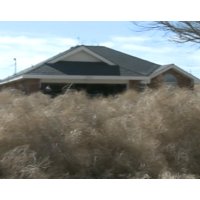Fungi War Looms against Tumbleweeds that Plague California

Back in June, state Senate Pro-Tem-elect Kevin de León (D-Los Angeles) angered the residents of California’s Central Valley when he argued against starting construction of the bullet train in that region because, “No one lives out there in the tumbleweeds.”
If tumbleweeds are a symbol of deserted wastelands barely suitable for human habitation—and they are—the rest of California is about to have an image problem.
The state’s three-year drought has helped introduce the non-native plants that produce the iconic nuisance to areas that were once too moist to support them. The result is a statewide infestation of green spindly bushes that threaten farming, and the dry, prickly tumbling tumbleweeds that are beginning to plague more urban areas.
That has scientists scrambling for a solution, and researchers at the U.S. Agricultural Research Service (ARS) think they have one. Dana Berner, an ARS pathologist, told Popular Science that after a decade of research scientists are ready to unleash two fungi—Colletotrichum salsolae and Uromyces salsolae—from the steppes of Eurasia that are known to kill tumbleweeds.
Although most people identify tumbleweeds with the Old West, they were first introduced to this country in the 1870s along with flax seed that was imported from Russia. In the past, they have mostly battled with other invasive plants like mustard for their environmental niche. But the drought has inspired them to branch out and take root in vegetation they once avoided.
The scientists applied for permission to go public with one of the fungi in 2009 and the other last year, but are still waiting for approval. One of the hang-ups could be a threat the fungi may pose to plants people don’t want killed. Scientists can’t test the fungi on every known living thing, but do have computer models for extrapolating what they do know, and the researchers at ARS are optimistic they have a safe product.
The fungi are cheap, easy to apply and ruthlessly effective. “It will eventually spread,” Berner said. “Ultimately, it’s going to spread as far as tumbleweed spread.”
David Bracken, a deputy commissioner for the Los Angeles County Department of Agriculture, told the Los Angeles Times that the problem descending on the region is cyclical and will pass in time. But that assumes the drought is just another one of those usual down times for the state, and climate change hasn’t changed the rules of the game.
For now, the problem is real and Oak Forest Canyon on the north side of the Santa Monica Mountains is a good example of how tumbleweeds are transforming landscapes. “This entire area averaged a few dozen tumbleweeds, which was of no concern,” Arnold Newman, a botanist and president of the local homeowners association, told the Times. “Now the canyon has an estimated 8,000 to 10,000 pale green sprouts.”
Those sprouts will turn into bushes before drying out, breaking off the plant, adopting their more familiar beige spiny persona and blowing about until they cluster with other tumbleweeds to produce a spooky ghost-town effect and formidable fire hazard.
–Ken Broder
To Learn More:
Unleashing an Epidemic to Kill the Tumbleweeds (by Francie Diep, Popular Science)
Scientists Plan to Kill Off the American West's Tumbleweeds (by Colin Schultz, Smithsonian)
Drought Triggers Southern California Tumbleweed Infestation (by Louis Sahagun, Los Angeles Times)
Tumbleweeds of California: Who, What, Where and How? (by Debra Ayres, Fred Ryan, Fred Hrusa and Pat Akers, University of California, Davis) (pdf)
- Top Stories
- Controversies
- Where is the Money Going?
- California and the Nation
- Appointments and Resignations
- Unusual News
- Latest News
- California Forbids U.S. Immigration Agents from Pretending to be Police
- California Lawmakers Urged to Strip “Self-Dealing” Tax Board of Its Duties
- Big Oil’s Grip on California
- Santa Cruz Police See Homeland Security Betrayal in Use of Gang Roundup as Cover for Immigration Raid
- Oil Companies Face Deadline to Stop Polluting California Groundwater





